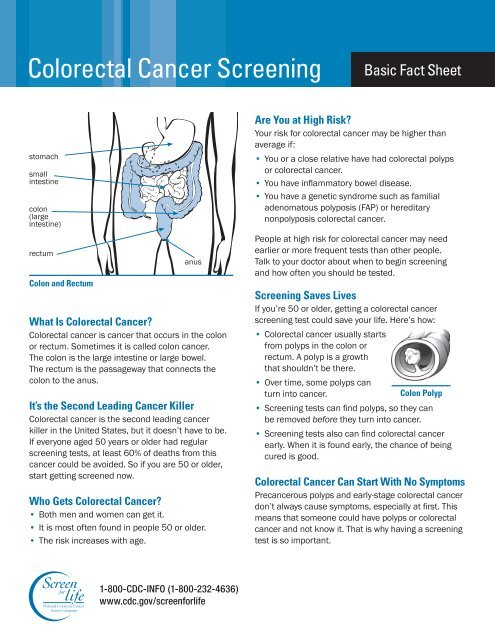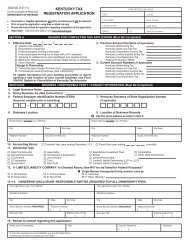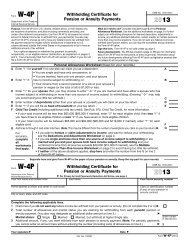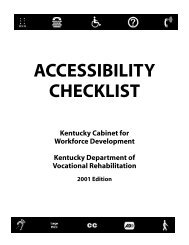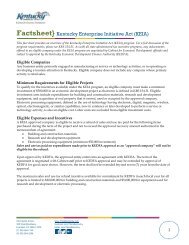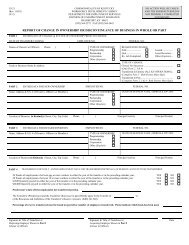Screen for Life: Basic Factsheet English (color) - Centers for Disease ...
Screen for Life: Basic Factsheet English (color) - Centers for Disease ...
Screen for Life: Basic Factsheet English (color) - Centers for Disease ...
You also want an ePaper? Increase the reach of your titles
YUMPU automatically turns print PDFs into web optimized ePapers that Google loves.
Colorectal Cancer <strong>Screen</strong>ing<br />
<strong>Basic</strong> Fact Sheet<br />
stomach<br />
small<br />
intestine<br />
colon<br />
(large<br />
intestine)<br />
rectum<br />
Colon and Rectum<br />
anus<br />
What Is Colorectal Cancer?<br />
Colorectal cancer is cancer that occurs in the colon<br />
or rectum. Sometimes it is called colon cancer.<br />
The colon is the large intestine or large bowel.<br />
The rectum is the passageway that connects the<br />
colon to the anus.<br />
It’s the Second Leading Cancer Killer<br />
Colorectal cancer is the second leading cancer<br />
killer in the United States, but it doesn’t have to be.<br />
If everyone aged 50 years or older had regular<br />
screening tests, at least 60% of deaths from this<br />
cancer could be avoided. So if you are 50 or older,<br />
start getting screened now.<br />
Who Gets Colorectal Cancer?<br />
• Both men and women can get it.<br />
• It is most often found in people 50 or older.<br />
• The risk increases with age.<br />
Are You at High Risk?<br />
Your risk <strong>for</strong> <strong>color</strong>ectal cancer may be higher than<br />
average if:<br />
• You or a close relative have had <strong>color</strong>ectal polyps<br />
or <strong>color</strong>ectal cancer.<br />
• You have inflammatory bowel disease.<br />
• You have a genetic syndrome such as familial<br />
adenomatous polyposis (FAP) or hereditary<br />
nonpolyposis <strong>color</strong>ectal cancer.<br />
People at high risk <strong>for</strong> <strong>color</strong>ectal cancer may need<br />
earlier or more frequent tests than other people.<br />
Talk to your doctor about when to begin screening<br />
and how often you should be tested.<br />
<strong>Screen</strong>ing Saves Lives<br />
If you’re 50 or older, getting a <strong>color</strong>ectal cancer<br />
screening test could save your life. Here’s how:<br />
• Colorectal cancer usually starts<br />
from polyps in the colon or<br />
rectum. A polyp is a growth<br />
that shouldn’t be there.<br />
• Over time, some polyps can<br />
turn into cancer.<br />
Colon Polyp<br />
• <strong>Screen</strong>ing tests can find polyps, so they can<br />
be removed be<strong>for</strong>e they turn into cancer.<br />
• <strong>Screen</strong>ing tests also can find <strong>color</strong>ectal cancer<br />
early. When it is found early, the chance of being<br />
cured is good.<br />
Colorectal Cancer Can Start With No Symptoms<br />
Precancerous polyps and early-stage <strong>color</strong>ectal cancer<br />
don’t always cause symptoms, especially at first. This<br />
means that someone could have polyps or <strong>color</strong>ectal<br />
cancer and not know it. That is why having a screening<br />
test is so important.<br />
1-800-CDC-INFO (1-800-232-4636)<br />
www.cdc.gov/screen<strong>for</strong>life
What Are the Symptoms?<br />
Some people with <strong>color</strong>ectal polyps or <strong>color</strong>ectal<br />
cancer do have symptoms. They may include:<br />
• Blood in or on your stool (bowel movement).<br />
• Stomach pain, aches, or cramps that don’t<br />
go away.<br />
• Losing weight and you don’t know why.<br />
If you have any of these symptoms, talk to your doctor.<br />
These symptoms may be caused by something other<br />
than cancer. However, the only way to know what is<br />
causing them is to see your doctor.<br />
Types of <strong>Screen</strong>ing Tests<br />
Several different screening tests can be used to find<br />
polyps or <strong>color</strong>ectal cancer. Each can be used alone.<br />
Sometimes they are used in combination with<br />
each other. The U.S. Preventive Services Task Force<br />
(USPSTF) recommends <strong>color</strong>ectal cancer screening<br />
<strong>for</strong> men and women aged 50–75 using high-sensitivity<br />
fecal occult blood testing (FOBT), sigmoidoscopy, or<br />
colonoscopy. Talk to your doctor about which test or<br />
tests are right <strong>for</strong> you. The decision to be screened<br />
after age 75 should be made on an individual basis.<br />
If you are older than 75, ask your doctor if you<br />
should be screened.<br />
• High-Sensitivity FOBT (Stool Test)<br />
There are two types of FOBT: One uses the<br />
chemical guaiac to detect blood. The other—a<br />
fecal immunochemical test (FIT)—uses antibodies<br />
to detect blood in the stool. You receive a test kit<br />
from your health care provider. At home, you use<br />
a stick or brush to obtain a small amount of stool.<br />
You return the test to the doctor or a lab, where<br />
stool samples are checked <strong>for</strong> blood.<br />
How Often: Once a year.<br />
• Flexible Sigmoidoscopy<br />
For this test, the doctor puts a short, thin, flexible,<br />
lighted tube into your rectum. The doctor checks<br />
<strong>for</strong> polyps or cancer inside the rectum and lower<br />
third of the colon.<br />
• Colonoscopy<br />
This is similar to flexible sigmoidoscopy, except the<br />
doctor uses a longer, thin, flexible, lighted tube to<br />
check <strong>for</strong> polyps or cancer inside the rectum and<br />
the entire colon. During the test, the doctor can<br />
find and remove most polyps and some cancers.<br />
How Often: Every 10 years.<br />
Colonoscopy also is used as a follow-up test if<br />
anything unusual is found during one of the other<br />
screening tests.<br />
Other <strong>Screen</strong>ing Tests in Use or Being Studied<br />
Although these tests are not recommended by the<br />
USPSTF, they are used in some settings and other<br />
groups may recommend them. Many insurance<br />
plans don’t cover these tests, and if anything<br />
unusual is found during the test, you likely will<br />
need a follow-up colonoscopy.<br />
• Double Contrast Barium Enema—You receive an<br />
enema with a liquid called barium, followed by an<br />
air enema. The barium and air create an outline<br />
around your colon, allowing the doctor to see the<br />
outline of your colon on an X-ray.<br />
• Virtual Colonoscopy—Uses X-rays and computers<br />
to produce images of the entire colon. The images<br />
are displayed on the computer screen.<br />
• Stool DNA Test—You collect an entire bowel<br />
movement and send it to a lab to be checked <strong>for</strong><br />
cancer cells.<br />
Will Insurance or Medicare Pay?<br />
Many insurance plans and Medicare help pay <strong>for</strong><br />
<strong>color</strong>ectal cancer screening tests. Check with your<br />
plan to find out which tests are covered <strong>for</strong> you. To find<br />
out about Medicare coverage, call 1-800-MEDICArE<br />
(1-800-633-4227) or visit www.medicare.gov.<br />
The Bottom Line<br />
If you’re 50 or older, talk with your doctor about<br />
getting screened. For more in<strong>for</strong>mation, visit<br />
How Often: Every five years. When done in<br />
www.cdc.gov/screen<strong>for</strong>life or call 1-800-CDC-INFO<br />
combination with a High-Sensitivity FOBT, (1-800-232-4636). For TTY, call 1-888-232-6348.<br />
the FOBT should be done every three years.<br />
U.S. DEPARTMENT OF HEALTH AND HUMAN SERVICES<br />
<strong>Centers</strong> <strong>for</strong> <strong>Disease</strong> Control and Prevention<br />
CDC Publication #99-6949 • Revised June 2009.


